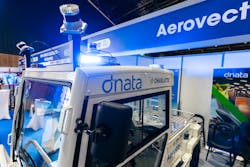According to the founders of AeroVect, their goal from the company’s start was to not just create autonomous technology for the ground support equipment (GSE) industry but to change how ground handling is performed at the world’s biggest airports.
“From the very beginning, we wanted to partner with the largest handlers,” AeroVect co-founder and COO Eugenio Donati said at the GSE Expo Europe in Paris, France, where AeroVect announced a partnership with dnata to pilot and deploy autonomous GSE at airports in the United States and elsewhere around the world.
AeroVect was able to secure a partnership with dnata, which operates in more than 35 countries on six continents, due in part to its AeroVect Driver technology’s ability to be applied to any OEM’s equipment.
“The autonomy that we’ve built is aviation first. The approach that we take is platform agnostic,” AeroVect co-founder and CEO Raymond Wang said. “At the end of the day, we want to serve our customers well. We want to serve the airlines well. We want to serve the handlers well.
“We truly have gone out there and put our platform on top of whatever vehicles the customer brings us.”
“We don’t want people to buy new vehicles, new GSE, just to make them autonomous,” Donati added, noting this method allows for faster scaling of autonomous tech.
“We partnered with AeroVect for certain reasons. One of them being that AeroVect is an OEM-agnostic company,” said Bartu Korgul, head of GSE planning at dnata. “We operate a diverse fleet globally. We consistently review our processes and invest in the latest technologies to deliver the highest level of service and safety. We want to work with suppliers that best meet our demands. We want to stay agnostic.
“AeroVect demonstrated a high level of expertise and enthusiasm,” he continued. “We share a passion for innovation and service excellence and support each other in achieving our targets.”
AeroVect leaders said it was clear early in discussions that dnata was forward-thinking and serious about pursuing autonomous technology.
“I still see some resistance in the industry. People are very cautious, but also some of them are not willing to explore technology. At dnata, we know that excellence means constantly challenging ourselves to do better. We want to understand what autonomy will bring us in terms of efficiency, reliability, safety and productivity,” Korgul said.
In order to understand how autonomous GSE will impact its operations, Korgul said dnata follows a phased approach toward implementation.
“This is the exploration phase. We have certain criteria that we want to assess together,” he explained. “If the trial is successful, then we’ll work on a deployment plan.”
To get to this point, Wang said the process has required a deep collaboration with dnata officials.
“A lot of times when you’re running these vehicles, it’s the first time they’ve had an autonomous vehicle in that airport. Even across airports, in general, autonomy is something that we’re at the forefront of developing. That will require partnership from ground handlers like dnata,” Wang said. “That’s the key thing for us – finding a partner that is the right fit there.”
“One of the exciting things about dnata, and Emirates more broadly, is that they are very long-term planners – long-term thinkers,” Donati added.
Through its partnership with dnata, AeroVect was able to better understand the ground handler’s operations across multiple stations in the United States and in Dubai. AeroVect made 3D maps of dnata’s major American hubs to facilitate the trial.
“I think from the outside, aviation can seem very scary and complex. I think that’s, to an extent, why a lot of people have been hesitant to go into this domain,” Donati said. “When you actually understand how things work – both at the specific ground handling level and also the interaction between handlers, airlines, OEMs, airports, that whole picture, you realize it’s doable.”
Wang said it is important to consider the airport operating domain in its entirety.
“Part of that means facing the realities of operating in an airport. You have a lot of niceties in terms of it’s a more structured domain compared to, for example, urban driving and highway trucking. But at the same time, the fact is, if you’re really operating at an airport, you’re going to be dealing with aircraft crossings. The fact is, if you’re going to be operating at an airport, you’re going to have to recognize other vehicles that look nothing like everyday vehicles that are on the road,” Wang said.
“That is something we very fundamentally realized,” he continued. “Focus on the airport. Serve the airport operating domain.”
With that focus on airport operations, the goal of GSE autonomy is to improve efficiencies and enhance safety.
“Autonomous drive is going to reduce, if not eliminate, the human factor. Today, most of the ground incidents are a result of human factors. We do hope autonomous vehicles will significantly enhance safety across the industry,” Korgul said.
dnata’s pilot of AeroVect’s self-driving technology is expected to begin soon at a major airport in the United States. The pilot will consist of the AeroVect Driver transporting cargo autonomously from a cargo warehouse to one of the airport’s terminals.
According to the announcement, the two companies plan in the coming years to deploy as many as 100 ground support vehicles equipped with autonomous technology at major airports worldwide, including Dubai International (DXB) and Dubai World Central (DWC).
Currently the AeroVect Driver technology is being installed on baggage and cargo tractors. However, Wang said the company intends to apply autonomous technology to other pieces of GSE in the future.
“At the end of the day, we want to be the world’s leading provider of autonomy for aviation. That means starting out in one very focused area, getting very good at this initial area and then growing from there,” Wang said.
“But we don’t want to rush that,” he added. “We want to make sure we get product No. 1 right and rock-solid and then we can go from there.”
About the Author
Josh Smith
Editor
Josh Smith served as editor of Ground Support Worldwide as editor from 2016 through 2024. He oversaw production of the print magazine, created GSW's newsletters on a daily basis, and updated the latest news on AviationPros.com.

